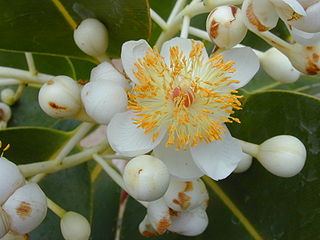
The Malpighiales comprise one of the largest orders of flowering plants, containing about 36 families and more than 16,000 species, about 7.8% of the eudicots. The order is very diverse, containing plants as different as the willow, violet, poinsettia, manchineel, rafflesia and coca plant, and are hard to recognize except with molecular phylogenetic evidence. It is not part of any of the classification systems based only on plant morphology. Molecular clock calculations estimate the origin of stem group Malpighiales at around 100 million years ago (Mya) and the origin of crown group Malpighiales at about 90 Mya.

Jean-Baptiste Pierre Antoine de Monet, chevalier de Lamarck, often known simply as Lamarck, was a French naturalist, biologist, academic, and soldier. He was an early proponent of the idea that biological evolution occurred and proceeded in accordance with natural laws.
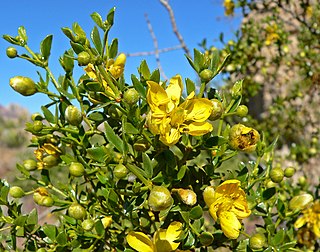
Zygophyllaceae is a family of flowering plants that contains the bean-caper and caltrop. The family includes around 285 species in 22 genera.

This is a list of topics in evolutionary biology.
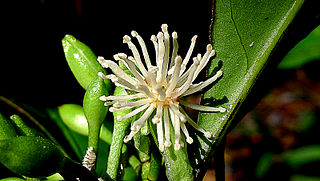
Tovomita is a genus of flowering plants in the family Clusiaceae. They are noted for having white-yellow latex and containing xanthones. The genus is distributed in the tropical Americas, with many occurring in Venezuela. Most are native to the forests of the Amazon.
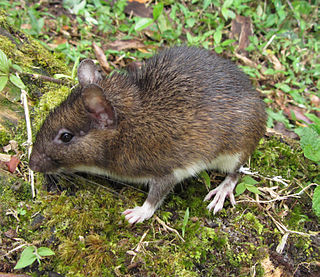
The Atlantic spiny rats are all found in the genus Trinomys. They are a group of South American spiny-rats in the family Echimyidae.
Ponerorchis capitata is a species of plant in the family Orchidaceae. It is endemic to China, known only from Sichuan and Hubei. It produces white flowers.
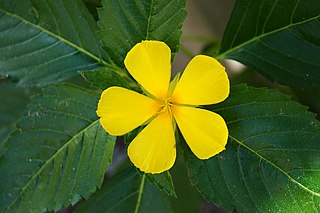
Turnera is a genus of flowering plants in the passionflower family, Passifloraceae. It contains more than 100 species native to tropical and subtropical America. The name honours English naturalist William Turner (1508–1568). It was previously placed in the family Turneraceae.
Osilinus is a genus of sea snails, marine gastropod mollusks in the family Trochidae, the top snails.

Turnera subulata is a species of flowering plant in the passionflower family known by the common names white buttercup, sulphur alder, politician's flower, dark-eyed turnera, and white alder. Despite its names, it is not related to the buttercups or the alders. It is native to Central and South America, from Panama south to Brazil. It is well known in many other places as an introduced species, such as Malaysia, Indonesia, several other Pacific Islands, the Caribbean, and Florida in the United States. It is commonly cultivated as a garden flower.

Thaisella coronata is a species of sea snail, a marine gastropod mollusk, in the family Muricidae, the murex snails or rock snails.
Schlumbergera lutea, synonym Hatiora epiphylloides, is a species of flowering plant in the family Cactaceae, subfamily Cactoideae, native to southeast Brazil. It is a shrubby epiphyte, with flattened stems and bright yellow flowers.

Myosotis capitata is a species of flowering plant in the family Boraginaceae, endemic to the Campbell and Auckland Islands of New Zealand. Joseph Dalton Hooker described the species in his 19th century work Flora Antarctica. Plants of this species of forget-me-not are perennial and erect, and have ebracteate inflorescences and blue corollas. It is one of two native species of Myosotis in the New Zealand subantarctic islands, the other being M. antarctica, which can also have blue corollas.

Adenoa is a monotypic genus of flowering plants belonging to Turneroideae (Passifloraceae).
Oxossia is a genus of flowering plants in the subfamily Turneroideae (Passifloraceae) consisting of 15 species. This genus was recently defined in 2019 after a phylogenetic analysis of Turnera justified the creation of the genus. The genus is characterized by its stipules, small flowers, congested inflorescences, "hairy" stamen and style, and the attachment of stamen to the floral tube. All members of the genus are heterostylous with the exception of O. dasystyla. The genus can be divided into two morphological groups: those with white petals and those with yellow pink or red petals.
Arboa berneriana is a shrub or tree that grows in the wet tropics of northern Madagascar. It has varying ranges of colors from yellow to orange to red.
Arboa madagascariensis is a woody plant with yellow flowers native to Madagascar.
Oxossia albicans is a subshrub in the genus Oxossia. It is native to the wet tropics of eastern Brazil.
Oxossia annularis is a shrub of Oxossia Turneroideae (Passifloraceae) native to eastern Brazil. O. annularis has 2–10 mm long petioles, rigid elliptical, ovate, or obovate leaves with serrated margins.
Oxossia calyptrocarpa, a member of Turneroideae (Passifloraceae), is a shrub native to the wet tropics of eastern Brazil. It is 0.2-2.5 meter tall with highly plasticitic leaves and white to lilac flowers.










